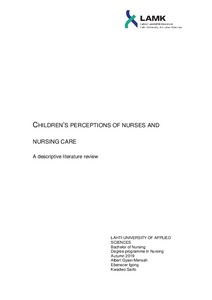Fall Prevention for Geriatric Patients in Nursing Home
Dela Cruz, Shayne Michelle; Bathan, Meriam; Ramos, Roncesvalles (2024)
Dela Cruz, Shayne Michelle
Bathan, Meriam
Ramos, Roncesvalles
2024
All rights reserved. This publication is copyrighted. You may download, display and print it for Your own personal use. Commercial use is prohibited.
Julkaisun pysyvä osoite on
https://urn.fi/URN:NBN:fi:amk-2024120533231
https://urn.fi/URN:NBN:fi:amk-2024120533231
Tiivistelmä
Purpose:
In long-term facilities, about 50 % of its geriatric patients experience fall each year. There is limited knowledge in the causes and prevention of fall and most of the data are only produced when incidences of fall occur as reported by either the staff or other witnesses. The purpose of this study was to describe the main causes of fall injuries and the ways to prevent falls in nursing homes. It aimed to provide new knowledge that can be utilized by nurses to improve practices to prevent risk for fall on geriatric patients in nursing homes.
Methods:
A qualitative study was utilized as a methodological approach. Descriptive literature review was used as a method. The selected articles were obtained from databases such as PubMed, CINAHL and Medline. A total of fifteen (15) articles were reviewed in accordance with inclusion and exclusion criteria. This study was analyzed through inductive content analysis.
Results:
The results of the study showed that the main causes of falls in geriatric patients in nursing homes include intrinsic factors, extrinsic factors and situational factors. The practices that could be implemented to prevent falls in geriatric patients in nursing homes were standardized fall prevention programs, safety strategies, education, cooperation and leadership and management.
Conclusion:
Long-term facilities may benefit from looking into the causes and practices that were identified, in which they can apply to their own protocol in their facilities. There is no evidence-based practice specific to nurses. Prevention of fall is already difficult to address and so, more studies need to be made in order to determine which specific practices are most effective in preventing falls in geriatric patients in nursing homes.
In long-term facilities, about 50 % of its geriatric patients experience fall each year. There is limited knowledge in the causes and prevention of fall and most of the data are only produced when incidences of fall occur as reported by either the staff or other witnesses. The purpose of this study was to describe the main causes of fall injuries and the ways to prevent falls in nursing homes. It aimed to provide new knowledge that can be utilized by nurses to improve practices to prevent risk for fall on geriatric patients in nursing homes.
Methods:
A qualitative study was utilized as a methodological approach. Descriptive literature review was used as a method. The selected articles were obtained from databases such as PubMed, CINAHL and Medline. A total of fifteen (15) articles were reviewed in accordance with inclusion and exclusion criteria. This study was analyzed through inductive content analysis.
Results:
The results of the study showed that the main causes of falls in geriatric patients in nursing homes include intrinsic factors, extrinsic factors and situational factors. The practices that could be implemented to prevent falls in geriatric patients in nursing homes were standardized fall prevention programs, safety strategies, education, cooperation and leadership and management.
Conclusion:
Long-term facilities may benefit from looking into the causes and practices that were identified, in which they can apply to their own protocol in their facilities. There is no evidence-based practice specific to nurses. Prevention of fall is already difficult to address and so, more studies need to be made in order to determine which specific practices are most effective in preventing falls in geriatric patients in nursing homes.
Kokoelmat
Samankaltainen aineisto
Näytetään aineisto, joilla on samankaltaisia nimekkeitä, tekijöitä tai asiasanoja.
-
Virtual Reality and its use in surgical nursing training : a literature review into the effectiveness of Virtual Reality as a new practical educational method for training Registered Nurses in surgical nursing
Jokinen, Felipe Ignacio (2021)The general purpose of this thesis was to review the literature available to Virtual Reality to ascertain if the technology has a possibility to augment or become a more effective way to train Registered Nurse students in ... -
Cultural Diversity in Finnish Health Care: A COMPARISON OF NURSE MANAGERS, NATIVE-FINNISH REGISTERED NURSES, AND IMMIGRANT REGISTERED NURSES PERSPECTIVES AND EXPERIENCES OF CULTURAL DIVERSITY IN THE FINNISH HEALTHCARE WORK ENVIRONMENT
Atanga, Josephine; Mwangi, Caroline; Ghimire, Dibya (2022)Background: There is a global scarcity of healthcare workers, particularly in Western countries such as Finland resulting in a greater reliance on foreign-trained professionals to fill the gap in the nursing workforce. ...Rajoitettu käyttöoikeus / Restricted access / Tillgången begränsad -
Children's perceptions of nurses and nursing care : A descriptive literature review
Gyasi-Mensah, Albert; Sarfo, Kwadwo; Igong, Ebenezer (2019)Hospitalization can be a very stressful and traumatic experience for children. Children have a limited understanding of procedures and hospital environment. Thus, it is even more important for health care professionals to ...


